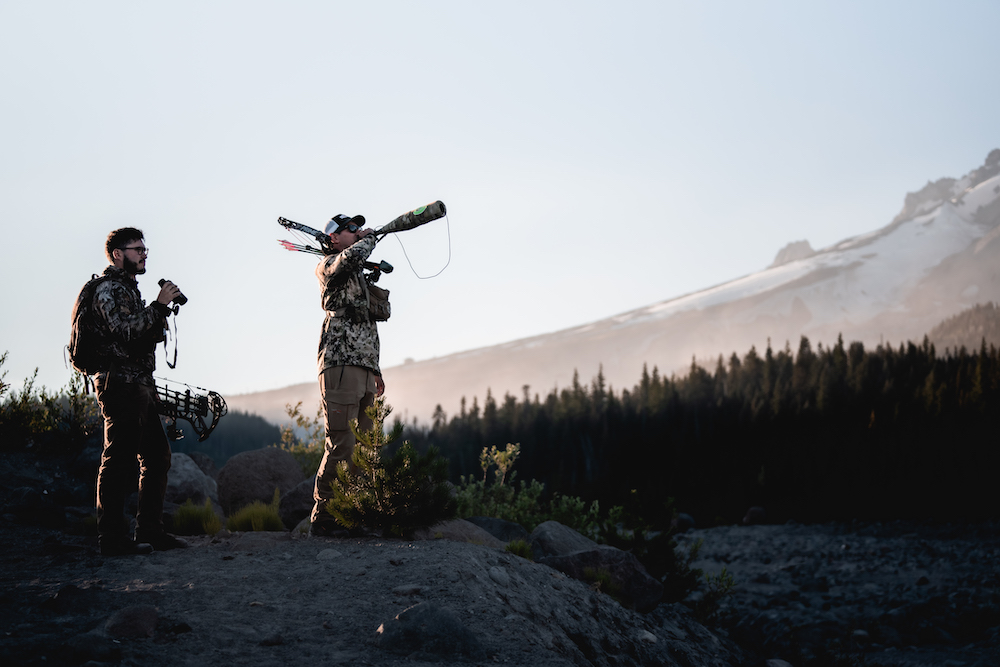Bow season is long, and your strategy will need to adapt along the way. Along with ever-changing seasonal and weather conditions, deer behavior is also constantly changing. This requires a delicate balance of aggressive and conservative hunting styles, but with a thorough understanding of deer behavior to determine the appropriate tactics for the appropriate time. If you’re after a particular big buck, should you venture into his core area, or play the waiting game on the fringe? Many factors, including time of year, rut phase, hunting pressure, and situational awareness dictate the best answer to that question.

Placing your stand or blind in the right location gives you a higher chance of spotting the deer naturally. Photo Credit: BU
A hot food source can cause predictable deer behavior, especially when the conditions are right. Opening day and the early season are ideal times to capitalize on late-summer feeding patterns. Deer are unpressured and focused on green food sources including soybeans, alfalfa and clover. A well-placed treestand on the downwind side of the food source with sneaky access that prevents deer bedded nearby from seeing you are critical factors for success. Increase your odds by monitoring a trail camera that overlooks the feeding area, and hunt the spot only when the conditions are perfect.
While food sources might go dormant during the middle of the season, they can be enticing during the late season. Keep an eye on the weather and target days with high barometric pressure and frigid temperatures, as these conditions motivate deer to feed in the daylight. Standing grain, such as corn or soybeans, is ideal but brassica blends with turnips and radishes are also an appealing cold-weather snack for bucks worn out after the rut. Similar to the early season, monitor your trail camera and strike when the conditions are right. One well-timed sit under ideal conditions will always be more effective than several mediocre hunts.
As effective as trail cameras are for observing feeding habits during the early and late seasons, don’t overlook their importance during the pre-rut and rut phases. Patterns can be observed any time of year, such as a buck that freshens a scrape on the cusp of daylight during mid-October, or a straggler that moseys his way back to bed through a transition area. Cellular cameras that send photos directly to your phone have made it easier than ever to gather intel. As popular as these tools have become, there’s still a place for traditional trail cameras that require an in-person visit to check. Ideal locations are those that can be easily accessed without alerting deer and that overlook focal points that concentrate deer such as scrapes, pinch points or the intersection of trails. Check cameras during midday hours, ideally during or just before a rain to wash your scent away. Let your trail camera data dictate your hunting decisions, especially if you have established stand locations nearby to ambush an unsuspecting buck.

If you’re not seeing bucks, try calling or using decoys and other more aggressive tactics. Photo Credit: BU
As exciting as it is to anticipate a buck strolling by your stand, there’s a time to be aggressive and bring him to you. Time of year, observed behavior and limited hunting time can help you determine when to push your chips in and go for broke. While aggressive tactics can be boom or bust, they always make for an exciting hunt.
The peak of the rut is a transformative phase in a buck’s behavior. During this time, their hormones surge, and their responsiveness to calls and decoys becomes heightened. Employing calls that mimic the sounds of an intruding buck or receptive doe can pique the curiosity of a buck bedded nearby, bringing him past your treestand at top pin distance.
Aggressive behavior among deer, especially when a buck asserts dominance over others, can open a window of opportunity. If you witness a dominant buck bullying smaller ones or exhibiting assertive behavior, he may be more susceptible to challenging calls and decoys. Luring him in with the impression of competition could yield a memorable encounter. Decoys are effective in these situations, especially in open areas with lots of visibility. A well-placed decoy positioned upwind of your treestand can infuriate a buck passing by and bring him in on a string. Whenever you’re calling or decoying, be mindful of the wind direction. Bucks will almost always circle downwind as they attempt to scent-check the area, so be sure to leave plenty of shooting lanes so that you don’t miss a shot opportunity before they catch your wind.
Sometimes time is short and opportunities are fleeting. In these instances, being aggressive in your approach can pay off. Employ scents, calls and decoys in a way that stirs curiosity and prompts action. While these tactics are commonly used during the rut, don’t overlook their effectiveness at other times of the year, especially if you’re on a short hunt out of state. This approach may not always succeed, but in moments of limited opportunity, the potential reward outweighs the risk.
There’s no right or wrong way to approach your hunting season. Trying new tactics is fun and helps you learn how to respond in new situations. If you’re looking for a fun challenge this season, consider trying something new. It just might result in a punched tag, full freezer, and memory you’ll never forget.